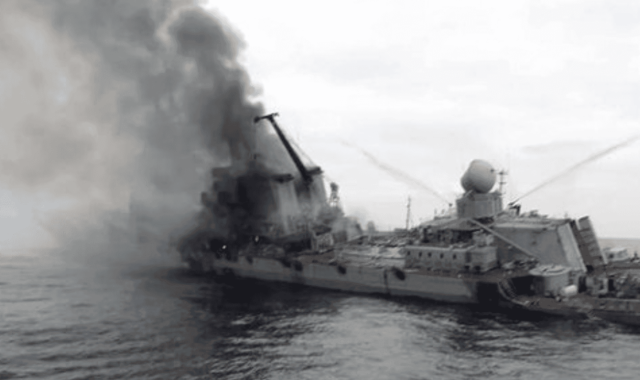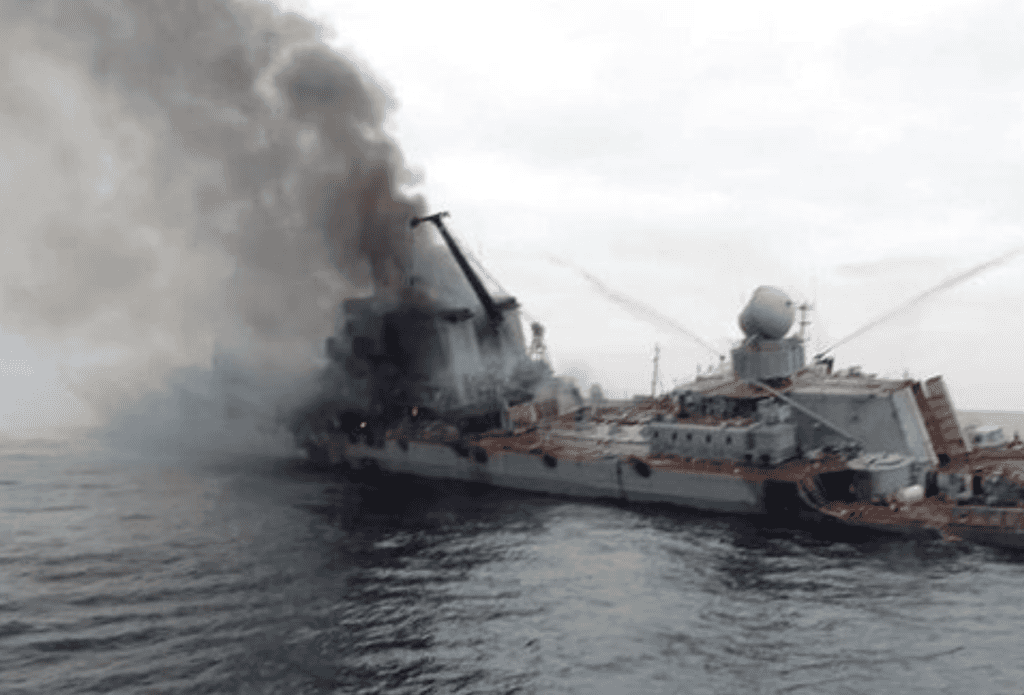
Report: US intel helped Ukraine sink Russian flagship warship An image purporting to show the damaged Russian Slava-class guided-missile cruiser Moskva in the Black Sea. (Screenshot).
The Ukrainian military was able to deal crippling blows to the Russian flagship missile cruiser Moskva, thanks in part to the intelligence sharing by the U.S. government, a new report revealed this week.
The Washington Post reported Thursday, citing people familiar with the matter, that the U.S. shared critical intelligence before Ukrainian forces launched their strike on the Slava-class missile cruiser Moskva (which means Moscow). Without that intelligence sharing, Ukrainian forces may not have been able to deliver the strikes against the warship.
The Russian side has said the warship Moskva was damaged on April 13 after a fire onboard the ship caused an ammunition detonation. The Russian military said it was towing the damaged ship but said it sank in a heavy storm. The Ukrainian side, by contrast, claims it struck the Moskva with a pair of domestically-produced R-360 Neptune anti-ship missiles, which heavily damaged the ship before it eventually sank.
Moskva had served as the flagship missile cruiser for Russia’s Black Sea fleet.
The Washington Post did not provide many details about what intelligence the U.S. side reportedly shared with Ukraine’s military prior to the sinking of the Moskva.
One U.S. official who spoke to the Washington Post said the U.S. had “no prior awareness” that Ukrainian forces had decided to strike the warship. The official said the U.S. has been providing Ukraine with “maritime awareness” which appears to indicate providing details about the whereabouts of Russian warships, which have been used to deliver missile strikes against Ukraine and could be used to support an amphibious assault.
Unnamed U.S. officials have said the U.S. has fed intelligence to Ukraine that it has used to kill Russian generals. U.S. officials told the New York Times that President Joe Biden’s administration is involved in a classified intelligence-sharing effort that’s providing targeting help against Russian officers. The U.S. is reportedly sharing insights on Russian troop movements and the locations of mobile headquarters, where Russian generals are likely located.
In a Thursday briefing, Pentagon Press Secretary John Kirby disputed the New York Times’ reporting, saying “the United States provides battlefield intelligence to help Ukrainians defend their country, and we’ve talked about that quite a bit. We do not provide intelligence on the location of senior military leaders on the battlefield or participate in the targeting decisions of the Ukrainian military.”
National Security Council (NSC) spokesperson Adrienne Watson also disputed reports of the U.S. helping Ukraine kill Russian generals. In a Tuesday statement reported by the Washington Post, Watson said, “The [United States] provides battlefield intelligence to help the Ukrainians defend their country. We do not provide intelligence with the intent to kill Russian generals.”
Unnamed officials also recently claimed U.S. intel helped Ukrainian forces shoot down a Russian transport plane carrying hundreds of troops in the early days of Russia’s invasion.
Moskva may have had little advanced notice of an attack, retired U.S. Navy Capt. Chris Carlson told USNI News. The retired officer studied photos of the warship taken before and after the April 13 explosion and noted photos taken after the strike show the ship’s radars “are in their normal stowed position.”

Carlson said Ukrainian Neptune missiles shouldn’t have been particularly challenging for the Russian warship to defend against. He noted the anti-ship missiles are based on a 40-year-old Soviet-era missile design which is itself based on the U.S. Harpoon anti-ship missile.
“This is like Harpoon. It’s a small missile. Its warhead is about 145 kilograms, travels less than 10 meters off the deck [and has] radar homing,” Carlson told USNI News. “This is not, shall we say, a stressing threat for air defense systems. It’s not supersonic.”
Carlson said the Russian warship’s radar systems should have been able to detect the Neptune missiles and countered them with its OSA-M surface to air missiles. But, Carlson noted that if the ship’s radar systems were stowed at the time of the attack, they wouldn’t have been able to direct the ship’s defensive systems.
“If you’re not running it, your point defense [surface to air missiles] are not going to be playing,” Carlson said.




